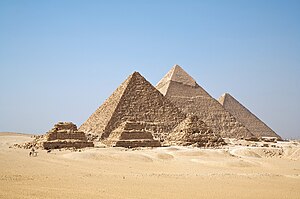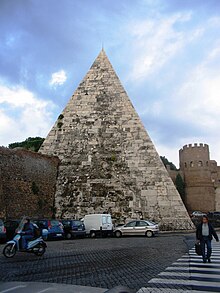Pyramid: Difference between revisions
Revert to revision 170185358 dated 2007-11-08 21:54:48 by VoABot II using popups |
|||
| Line 27: | Line 27: | ||
There is a Roman era [[French pyramids|pyramid]] built in [[Falicon]], France. There were many more pyramids made in France in this period. |
There is a Roman era [[French pyramids|pyramid]] built in [[Falicon]], France. There were many more pyramids made in France in this period. |
||
===Greece=== |
|||
There are several structures in Greece that archaeologists have called pyramids. Dotted throughout the landscape are remains of buildings that were described by ancient travelers as pyramids, they were first excavated by Americans and Germans in the early 1930s and the 1990s. |
|||
[[Pausanias (geographer)|Pausanias]], a Greek traveler in the second century A.D. described several of the structures as pyramids. One of these pyramids was located in Helleniko, Ελληνικό in Greek,a village near [[Argos]] near the ancient ruins of Tiryns.<ref> Helleniko Pyramid http://www.grecoreport.com/pyramids_in_ancient_greece.htm</ref> The story surrounding the monument was that it was built as a polyandria, a common grave, for those soldiers who had fallen in the struggle for the throne of Argos back in the 14th Century B.C. He described the structure as something that resembled a pyramid with the decorations of Argolic shields, showing the military connection to it. Another pyramid that Pausanias saw on his journeys was at Kenchreai, another polyandria dedicated to the Argives and Spartans who lost their lives at the Battle of Hysiai in 669 B.C. Unfortunately neither of these structures remain fully intact today to test how closely they resembled the pyramids of [[Egypt]] nor is there any proof that they even resembled an Egyptian pyramid at all. |
|||
There are two surviving pyramid-like structures still available to study, one at Helleniko and the other at Ligourio, a village near the ancient theatre Epidaurus. With these two pyramid’s base stones remaining, it is possible to determine that Grecian pyramids existed, but were not used as the Egyptians used them. These buildings were not constructed in the same manner as the pyramids in Egypt. The buildings at Helleniko and Ligourio were no more than 100 feet tall and were surrounded by walls, with the base of the Helleniko pyramid being nine meters by 7 meters. The stone used to build the pyramids was limestone quarried locally and was cut to fit, not into freestanding blocks like the [[Great Pyramid of Giza]]. The base of the structures also differed from the Egyptian pyramids as they were rectangular, not square. This simple construction shape made it very difficult to make the top of the building come together in a point. As such, it makes more sense that these structures could have been peaked by a roof or platform. |
|||
There are no remains or graves in or near the structures. Instead, the rooms that the walls housed were made to be locked from the inside. This coupled with the platform roof, means that one of the functions these structures could have served was as watchtowers. Another possibility for the buildings is that they are shrines to heroes and soldiers of ancient times, but the lock on the inside makes no sense for such a purpose. |
|||
The dating of these ‘pyramids’ has been made from the pot shards excavated from the floor and on the grounds. The latest dates available from scientific dating have been estimated around the 5th and 4th centuries. There are many researchers who have given dates to the structures that pre-date the pyramids at Giza, but the method to obtain these dates was thermoluminescence of the stone. Normally this technique is used for dating pottery, but here researchers have used it to try and date stone flakes from the walls of the structures. This has created some debate about whether or not these ‘pyramids’ are actually older than Egypt, which is part of the Black Athena controversy. The basis for their use of thermoluminescence in order to date these structures is a new method of collecting samples for testing. Scientists from laboratories hired out by the recent excavators of the site, The Academy of Athens, say that they can use the electrons trapped on the inner surface of the stones to positively identify the date that the stones were quarried and put together. |
|||
The issue with this method is that they date the pyramids with a margin of error of up to over 700 years. This method dated the Helleniko pyramid to 2730 B.C. with an error factor of plus or minus 720 years. It also dated the Ligourio pyramid to 2260 B.C. with an error of plus or minus 710 years. Though these initial dates are indicative of these structures being built before the pyramid complex at Giza, it also means that they could have been built well after Khufu’s Great Pyramid was erected. Some archaeologists, however, have indicated that these samples may have been very select in their choice of which stones to sample. Further excavations of the site at Helleniko reveal that it was constructed on a previously existing structure, giving a possibility that the new methods of dating may be a misinterpretation. |
|||
Along with these two structures there are 14 more pyramid-like buildings, or their remains, scattered throughout the rest of the country side of Greece. These sites do not get as much attention as the two at Helleniko and Ligourio as they are the only ones mentioned in surviving accounts of ancient travelers. |
|||
===India=== |
===India=== |
||
Revision as of 01:24, 11 November 2007
This article needs additional citations for verification. (August 2006) |
- For other meanings, see pyramid (disambiguation).

A pyramid is any three-dimensional structure where the upper surfaces are triangular and converge on one point (apex). The base of pyramids are usually quadrilateral or trilateral (but generally may be of any polygon shape), meaning that a pyramid usually has four or three sides. The measurements of these triangles uniformly classify the shape as isosceles and sometimes equilateral.
Ancient monuments
Pyramid-shaped structures were built by many ancient civilizations.
China
There are many flat-topped pyramids in China. The First Emperor of Qin (circa 221 B.C.) was buried under a large pyramid outside modern day Xi'an. In the following centuries about a dozen more Han Dynasty royals were also buried under flat-topped pyramidal earth works.
Egyptian pyramids

The most famous pyramids are the Egyptian pyramids — huge structures built of brick or stone, some of which are among the largest man-made constructions. In Ancient Egypt, a pyramid was referred to as mer, literally "place of ascendance." The Great Pyramid of Giza is the largest in Egypt and one of the largest in the world. Until Lincoln Cathedral was built in 1300 A.D., it was the tallest building in the world. The base is over 13 acres in area.
It is one of the Seven Wonders of the World, and the only one of the seven to survive into modern times. The Ancient Egyptians capped the peaks of their pyramids with gold and covered their faces with polished white limestone, though many of the stones used for the purpose have fallen or been removed for other structures.
France
There is a Roman era pyramid built in Falicon, France. There were many more pyramids made in France in this period.
India

Many giant granite temple pyramids were made in South India during the Chola Empire, many of which are still in religious use today. Examples of such pyramid temples include Brihadisvara Temple at Thanjavur, the Temple of Gangaikondacholisvaram and the Airavatesvara Temple at Darasuram. However the largest temple pyramid in the area is Sri Rangam in Srirangam, Tamil Nadu. The Brihadisvara Temple was declared by UNESCO as a World Heritage Site in 1987; the Temple of Gangaikondacholisvaram and the Airavatesvara Temple at Darasuram were added as extensions to the site in 2004.[1]
Mesoamerican pyramids

A number of Mesoamerican cultures also built pyramid-shaped structures. Mesoamerican pyramids were usually stepped, with temples on top, more similar to the Mesopotamian ziggurat than the Egyptian pyramid. The largest pyramid by volume is the Great Pyramid of Cholula, in the Mexican state of Puebla. This pyramid is considered the largest monument ever constructed anywhere in the world, and is still being excavated. There is an unusual pyramid with a circular plan at the site of Cuicuilco, now inside Mexico City and mostly covered with lava from an ancient eruption of Xictli. Pyramids in Mexico were often used as places of human sacrifice.
Mesopotamian pyramids
The Mesopotamians also built pyramids, called ziggurats. In ancient times these were brightly painted. Since they were constructed of mud-brick, little remains of them. The Biblical Tower of Babel is believed to have been a Babylonian ziggurat.
North American pyramids
Many mound-building societies of ancient North America built large pyramidal earth structures known as platform mounds. Among the largest and best-known of these structures is Monk's Mound at the site of Cahokia, which has a base larger than that of the Great Pyramid at Giza. While the North American mounds' precise function is not known, they are believed to have played a central role in the mound-building people's religious life.
Nubian pyramids
Nubian pyramids were constructed (roughly 220 of them) at three sites in Nubia to serve as tombs for the kings and queens of Napata and Meroë.
The Nubians built more pyramids than the Egyptians, but they are smaller. The Nubian pyramids were constructed at a steeper angle than Egyptian ones and were monuments to dead kings[citation needed].
Pyramids were still being built in Nubia up to AD 300.
Rome

The 27-meter-high Pyramid of Cestius was built by the end of the first century BC and still exists today, close to the Porta San Paolo. Another one, named Meta Romuli, standing in the Ager Vaticanus (today's Borgo), was destroyed at the end of the 15th century.
These Roman imitations of Egyptian monuments are important as contemporary "portraits" of the Egyptian ones, providing some sense of their original color and smoothness.
Medieval Europe
Pyramids have occasionally been used in Christian architecture of the feudal era, e.g. as the tower of Oviedo's Gothic Cathedral of San Salvador. In some cases this leads to speculations on masonic or other symbolical intentions.
Modern pyramids
Examples of modern pyramids are:
- The Louvre Pyramid in Paris, France, in the court of the Louvre Museum, is a 20.6 meter (about 70 foot) glass structure which acts as an entrance to the museum. It was designed by the American architect I. M. Pei and completed in 1989.
- The Transamerica Pyramid in San Francisco, California, designed by William Pereira.
- The 32-story Pyramid Arena in Memphis, Tennessee (built in 1991) was the home court for the University of Memphis men's basketball program, and the National Basketball Association's Memphis Grizzlies until 2004.
- The Slovak radio building in Bratislava, Slovakia. This building is shaped like an inverted pyramid.
- The Walter Pyramid, home of the basketball and volleyball teams of the California State University, Long Beach, campus in California, United States, is an 18-story-tall blue pyramid.
- The Luxor Hotel in Las Vegas, United States, is a 30-story pyramid with light beaming from the top.
- The Summum Pyramid, a 3 story pyramid in Salt Lake City, Utah, used for instruction in the Summum philosophy and conducting rites associated with Modern Mummification.
- The Palace of Peace and Reconciliation in Astana, Kazakhstan.
- The three pyramids of Moody Gardens in Galveston, Texas.
- The Co-Op Bank Pyramid or Stockport Pyramid in Stockport, England is a large pyramid-shaped office block in Stockport in England. (The surrounding part of the valley of the upper Mersey has sometimes been called the "Kings Valley" after the Valley of the Kings in Egypt.)
- The GoJa Music Hall in Prague.
- The Muttart Conservatory greenhouses in Edmonton, Alberta.
- The unfinished Ryugyong Hotel in Pyongyang.
- Small pyramids similar to those of the Louvre can be found outside the lobby of the Citicorp Building in Long Island City, Queens NY.
Gallery
-
The Pyramid Arena in Memphis, Tennessee
-
Metairie Cemetery, New Orleans
-
Transamerica Pyramid
-
Stockport Pyramid in Stockport, United Kingdom
References
- Patricia Blackwell Gary and Richard Talcott, "Stargazing in Ancient Egypt," Astronomy, June 2006, pp. 62-67.
- Fagan, Garrett. "Archaeological Fantasies." RoutledgeFalmer. 2006
External links
- pyramids Surface Area MATHguide
- pyramids Volume MATHguide
- Paper models of pyramids Cheops pyramid and others








